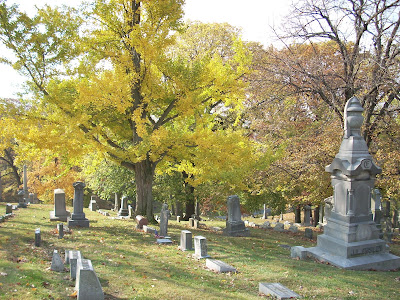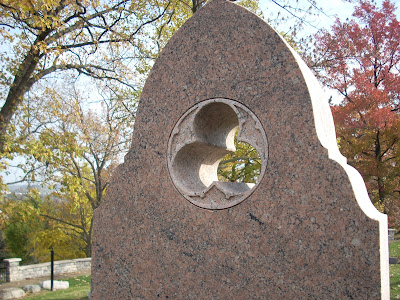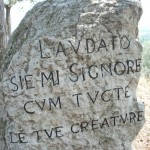I took my lunch to Woodland Cemetery and Arboretum today–one of my favorite spots in this, my adopted hometown, in which I celebrate 16 years (though only my fourth anniversary, since I arrived on Leap Day) today. Woodland is beautiful in any season, but in today’s preternaturally soft (68 degrees!) early spring mistiness, it was particularly peaceful. The opposite of the newswires, and my soul.
I got to thinking, as everyone who sits in a cemetery and thinks for more than a minute and a half has thought, what a restorative thing it can be to spend a little time among the dead. The battles that seem so critical, the bills that press, the words that cut to the heart, the fears of being foolish–really, what do they matter? We’re dead so very much longer than we’re alive and worrying. Thomas Gray’s 18th-century “Elegy Written in a Country Churchyard” is dated and precious now, but still true:
The boast of heraldry, the pomp of power,
And all that beauty, all that wealth e’er gave,
Awaits alike the inevitable hour:–
The paths of glory lead but to the grave.
Perspective. That’s what doing time in the graveyard offers. My Puritan New England forebears were better at recognizing that than we are, with their winged hourglasses and skulls where we cover tombstones with laser-etched replicas of our pets and our hobbies. In this life that flies by, what matters most? What am I doing with this day–this extra 24 hours in the year–that will have made any difference at all by the time I reach the inevitable hour?
It’s a pretty good bet that arguing with people in comboxes doesn’t qualify (though the heartburn might hasten the inevitable hour). Nor will reading more dispatches from the frontlines of the Pelvic Wars. Yesterday’s New York Times, for example, brought this completely unsurprising editorial attempt to wedge the attack on Catholic conscience even deeper into the health care battlefield. “Women’s Health Care at Risk,” reads the headline over the warning that “a wave of mergers between Catholic and secular hospitals is threatening to deprive women of access to important reproductive services.” So now we’re not just making women sick by refusing to pay for free contraceptives for our employees; we’re withholding critical care. That these “important reproductive services”–“Catholic hospitals have refused to terminate pregnancies, provide contraceptive services, offer a standard treatment for ectopic pregnancies, or allow sterilization after caesarean sections,” all of which violate Catholic teaching on the sanctity of life–are in actual fact nonreproductive services is something nobody seems to be willing to discuss. (Is it just me?)
There’s also a flurry of Planned Parenthood influenced pieces showing up in the Health sections of the major dailies this week, touting–as I predicted after reading the PP-sponsored research behind the Institute of Medicine report that motivated the HHS mandate, much of which is picked up directly in these articles–the health and cost benefits of IUDs. This example even points readers to the online chat room IUD Divas, where women share their experiences with this “worry-free” method of contraception. (That might backfire. I spent enough time reading the message threads at IUD Divas this morning to need to run away to the cemetery. With all the bleeding, cramping, loss of libido, fears of expulsion, need to use backup methods, difficulties with insertion, and recommendations of heavy pain meds, “worry-free” doesn’t seem to be quite the right term.)
IUDs, whether mechanical or hormonal in function, and injectables like Depo-Provera are the gold standard of “preventive medicine” (when the disease is pregnancy) because they don’t require compliance at the time of sexual activity, but they’re expensive, so to make them available to the “risk pool” of poor, young, uneducated, and minority women, they need to be made universally available free of charge. No mention of the diseases that IUDs cause, like chronic pelvic pain and and persistent yeast infections, or the ones they don’t prevent, like STDs and HIV. Ah, but that way lies more heartburn.
And no use pointing any of this stuff out in any public forum, because I’m Catholic, and you know how we are. I said to someone today that Fat and Catholic are the only two groups it’s still acceptable for tolerant, politically correct people to judge, hate, and ridicule, and God help me, I’m both of them. So it was off to the cemetery for the longer view.
When I was growing up, my dad worked rotating shifts in his job at a chemical plant. One week on days–7am to 3pm. One week on swing–3pm to 11pm. (That week, my sister and I came home for lunch so we could have dinner at noon as a family.) One week 11pm to 7am, and then 5 days off. The overnight week, the graveyard shift, was toughest on his body and the family and the neighborhood, because my mother would spend the whole day yelling out the apartment window at the local kids to be quiet so dad could get some rest. I’m sure the disturbed sleep cycle contributed to the alcoholism he was already using to self-medicate his tendency toward depression.













